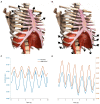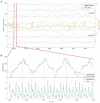Breath Tools: A Synthesis of Evidence-Based Breathing Strategies to Enhance Human Running
- PMID: 35370762
- PMCID: PMC8967998
- DOI: 10.3389/fphys.2022.813243
Breath Tools: A Synthesis of Evidence-Based Breathing Strategies to Enhance Human Running
Abstract
Running is among the most popular sporting hobbies and often chosen specifically for intrinsic psychological benefits. However, up to 40% of runners may experience exercise-induced dyspnoea as a result of cascading physiological phenomena, possibly causing negative psychological states or barriers to participation. Breathing techniques such as slow, deep breathing have proven benefits at rest, but it is unclear if they can be used during exercise to address respiratory limitations or improve performance. While direct experimental evidence is limited, diverse findings from exercise physiology and sports science combined with anecdotal knowledge from Yoga, meditation, and breathwork suggest that many aspects of breathing could be improved via purposeful strategies. Hence, we sought to synthesize these disparate sources to create a new theoretical framework called "Breath Tools" proposing breathing strategies for use during running to improve tolerance, performance, and lower barriers to long-term enjoyment.
Keywords: breathing pattern; coupling; respiration; running; strategies; techniques; ventilation.
Copyright © 2022 Harbour, Stöggl, Schwameder and Finkenzeller.
Conflict of interest statement
The authors declare that the research was conducted in the absence of any commercial or financial relationships that could be construed as a potential conflict of interest.
Figures








References
Publication types
LinkOut - more resources
Full Text Sources

